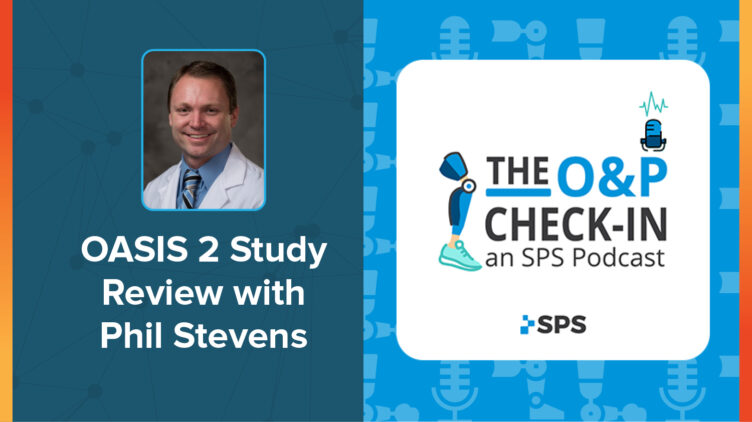O&P Podcast | OASIS 2 Study Review with Phil Stevens

In this edition of the O&P Check-In podcast, Phil Stevens, MEd, CPO, FAAOP, Director of Clinical and Scientific Affairs, shares further insight into the OASIS series and OASIS 2 study that compared patient-reported functional mobility differences with prosthetic feet across procedure codes using real-world clinical outcome data.
Recapping the OASIS 2 Discussion
What is the goal of the OASIS series?
The Outcomes ASsessment and DISsemination (OASIS) series is intended to be a series of studies comparing the effectiveness of a variety of orthotic and prosthetic components across different patient groups to ultimately impact and enhance patient outcomes.
Can you first tell us about the OASIS 1 study?
The OASIS 1 study tackled microprocessor knees (MPKs). We looked retrospectively at about 600 patients using 1 of the 4 most commonly provided MPKs in the industry. In this study, we investigated prosthetic mobility, self-reported well-being, and most importantly injurious fall rates. And what we found was while there was relative parity with respect to things like mobility and well-being, there were some significant differences with respect to the rate of injurious falls experienced by these users. So that data and that paper began to suggest that there were some important differences in the performance of these different makes and models of MPKs.
How does the OASIS 1 study relate to OASIS 2 study?
The OASIS 1 study focused on knees and MPKs, while the OASIS 2 study focused on feet. We felt like it would be appropriate to begin to look at the prosthetic mobility associated with different feet types, especially the mobility associated with the L5987 billing code. At the end of 2020, PDAC made some pretty impactful coding assignments based on the presence or absence of mechanical features instead of biomechanical performance. That’s problematic because there are some pretty high-performance feet out there that derive similar biomechanical performance from things like advanced materials and geometries without the added weight and build height of a distinct mechanical feature.
Tell us more about the OASIS 2 study.
In the OASIS 2 study, we did a retrospective analysis that looked at over 500 patients and broke them down into four groups.
- Sustained-87: Prosthetic feet which remained coded as L5987 base code
- Modified: Prosthetic feet historically billed as the L5987 base code, but PDAC reassigned to the L5981 base code
- Not Reviewed: Feet historically billed as L5987 base code but not submitted to PDAC
- Original-81: Prosthetic feet PDAC originally assigned to the L5981 base code
With all of these feet, we looked at the associated prosthetic mobility of their users. Our hypothesis was that the prosthetic mobility of the feet associated with the newly assigned L5981 code, in the modified feet category, would perform closer to the Sustained-87 feet than the Original-81 feet.
What were the key takeaways from the OASIS 2 study?
- Prosthetic mobility is higher among users of L5987 feet than users of L5981 feet. We saw similar results in an earlier publication from our MAAT 5 study where we looked at prosthetic mobility among diabetic and dysvascular patients.
- There is no significant difference in functional mobility for individuals with prosthetic feet that had their legacy L5987 coding modified to the L5981 code compared to those feet that retained their L5987 code designation.
Why are these results significant for improving patient outcomes?
Our results highlight a few things – L5987 code feet are associated with higher levels of prosthetic mobility than the L5981 code feet. Some of the feet that were reassigned as L5981 feet certainly performed at a level much higher than the legacy L5981 feet.
These real-world clinical outcomes suggest that measured functional performance may be preferable to visible characteristics as a pathway towards the highest performance for the end user. Having the ability to objectively measure, analyze, and disseminate real-world functional outcomes can enable clinical providers to make informed unbiased decisions about patient care which will ultimately result in enhanced outcomes.
Why does Hanger Institute conduct studies like the OASIS series?
Hanger Institute is uniquely positioned to provide insight and answer questions that have not been historically answered. When you think about the breadth of our patient care across the country and couple that with our commitment to the collection of validated outcomes, we have a lot of data. And in the era where healthcare decisions are expected to be informed by data, we’ve been able to start to provide some of those types of resources.
What’s next for OASIS?
We have not chosen our next set of clinical questions to address, but the hallmark of this clinical OASIS series will continue to be our ability to get a little bit more granular than a product category and actually look at the specific performance of individual components.
Anything else to add or touch on?
Thanks to all those involved in the project, co-authors, colleagues around the country who integrate outcomes into their daily practice habits, and the patients who take the time to complete those outcomes. Thank you for your help in facilitating the data needed to better inform patient care in the field.

More Published Research
The OASIS series is part of a vast collection of landmark research studies already published, or in various stages of publication by the Hanger Institute for Clinical Research and Education, in collaboration with leading researchers, clinical, and academic institutions.
Latest Updates
Subscribe to stay up-to-date on our latest posts.


